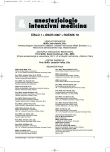Automatic control of rocuronium-induced neuromuscular block during long-lasting neurosurgical interventions
Authors:
M. Adamus 1; R. Bělohlávek 2
Authors‘ workplace:
Klinika anesteziologie a resuscitace, FN a LF Univerzity Palackého, Olomouc
1; Katedra informatiky, Přírodovědecká fakulta Univerzity Palackého, Olomouc
2
Published in:
Anest. intenziv. Med., 18, 2007, č. 1, s. 24-29
Category:
Anaesthesiology - Original Paper
Overview
Objective:
During balanced anaesthesia, the degree of neuromuscular block (NMB) must be sufficient to provide adequate surgical conditions but not as excessive as to make it difficult to reverse at the end of surgery. A continuous relaxant infusion is an appropriate technique for long-lasting operations but manual control of the infusion rate can be time-consuming.We present a device (both hardware and software) for fuzzy control of NMB during general anaesthesia.
Design:
Clinical, prospective study.
Setting:
Department of Anaesthesiology and Intensive Care Medicine, University Hospital.
Materials and methods:
After local ethics committee approval and informed consent, the Relax 2005 system was clinically used in 80 patients undergoing intracranial neurosurgical intervention to maintain a stable depth of NMB during total i. v. anaesthesia. The degree of block (TOF-ratio, T₁) was determined using a Datex-Ohmeda S/5TM monitor wirelessly interfaced to a PC for data collection; the computer was programmed to ensure a stable level (target T₁ = 10% of baseline) of block by controlling the rocuronium (ROC) infusion pump. The effectiveness of regulation was assessed by ROC consumption and root mean square deviation (RMSD) as an index of T₁ variation around the preset NMB level.
Results:
The mean duration of surgery was 171.7 (SD 81.4) minutes. During the regulation phase the system automatically maintained a stable degree of NMB with mean T₁ error -0.19 (0.26) % and RMSD 1.02 (0.72) %. The ROC consumption was 0.31 (0.23) mg.kg⁻¹.hr⁻¹. After discontinuation of the infusion adequate recovery from the block was reached within 15 minutes.
Conclusion:
Based on mean T₁ deviation from the target and RMSD values, the precision of regulation was far beyond the clinical requirements. The ROC consumption was at the lower limit recommended by the manufacturer.
Keywords:
neuromuscular block – rocuronium – fuzzy logic – automatic control
Labels
Anaesthesiology, Resuscitation and Inten Intensive Care MedicineArticle was published in
Anaesthesiology and Intensive Care Medicine

2007 Issue 1
Most read in this issue
- The American Society of Anesthesiologists’ (ASA) Classification of Physical Status – time for change?
- Lev Spinadel – founder of anaesthesiology in Czechoslovakia
- Incidence of postoperative residual curarization following cisatracurium and rocuronium-induced neuromuscular block: a prospective study
- Early urine and blood biochemical changes in experimental model of sepsis
